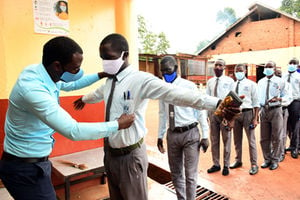Uganda faces setback in Aids fight with 38,000 new HIV cases in 2023

L-R: Busitema University chancellor Vinand Mukatabala Nantulya, Uganda Aids Commission director of planning and strategic information Vincent Bagambe, and Health minister Jane Ruth Aceng during the National HIV/Aids Symposium 2024 in Kampala on November 13, 2024. PHOTO | SYLIVIA KATUSHABE
What you need to know:
- More efforts needed to end Aids by 2030, says UAC.
The Uganda Aids Commission (UAC) has raised concerns about the high number of new HIV infections registered in the country annually, which may hinder Uganda’s goal to end Aids by 2030.
Dr Vincent Bagambe, the director of planning and strategic information at UAC, said although new infections have continued to decline over the years, the numbers are still high, adding that if the country is to hit its goal, new annual infections and deaths should be below 10,000.
According to the Annual Joint Aids Review Report 2023/2024, the country registered 38,000 new infections by the end of 2023 which translates into 730 new infections registered every week.
“The report shows that new HIV infections and Aids-related deaths have reduced. However, they are not reducing fast enough to enable us to reach the targets we expected to get in 2025, and that also means that the country is at risk of not achieving the goal of ending Aids by 2030, unless we double our efforts to further reduce new HIV infections to less than 10,000 per year and Aids-related deaths to less than 10,000 people per year,” Dr Bagambe said.
He was speaking during the National HIV/Aids symposium 2024 in Kampala on Wednesday.
Dr Bagambe revealed that adolescent girls and young women bear the largest burden of new HIV infections. Of the total 38,000, 22,000 were registered among women aged 15 years and above, 11,000 among men aged 15 and above, 15,000 among all young people aged 14 to 25 years, 6,600 among adolescents aged between 10 and 19 and 4,700 among children from zero to 14 years.
Issue
The report shows that HIV prevalence remains higher in females at 6.6 percent than in males at 3.6 percent. It also indicates that 80 percent of the new HIV infections among young people were adolescent girls.
However, Dr Bagambe noted that the government and partners have put in place a number of interventions like condom distribution among the key population, ensuring that everyone who tests positive is put on treatment to prevent transmission to those who are not yet infected, among other interventions.
Dr Jane Ruth Aceng, the minister of Health, said the decline in new infections is not worth celebrating but determination to keep on pushing to end Aids.
“Where we have come from was high, but this is not good. We should not even be talking about thousands. Nonetheless, it shows that our interventions are working,” Dr Aceng said.
She said the HIV epidemic has robbed the economy of $540m annually, which money would have been used to develop the economy.
“Currently we have about 1.4 million people on ARVs, the older ones will die away, the new cases are coming in, so you keep that money locked for generations in HIV but imagine a situation where that money is released to develop the economy, Uganda would be far ahead,” Dr Aceng said.
The minister said there is still a need for combined efforts to disseminate information as well as end mother-to-child transmission.
Mr Yunus Kakande, the secretary in the office of the President, said new innovation should be brought on board.
“We hope that new innovations such as the use of injectable medicine if rolled out will greatly improve the accessibility and consistent use of HIV prevention services,” Mr Kakande said.
The new report revealed that although Uganda has made progress in the last four years in combating HIV and Aids epidemic, by the end of June, the country has an estimated 1,492,410 people living with HIV including 71,833 children below the age of 15 years and the rest are adults. Aids-related death declined from 23,000 in 2020 to 20,000 in 2023.



